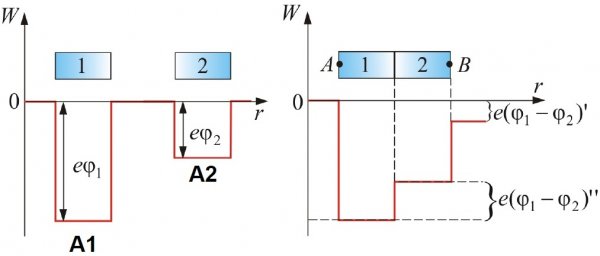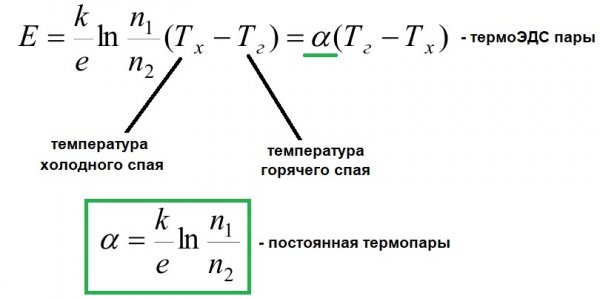The thermoelectric Seebeck effect: what is it? How thermocouples and thermoelectric generators work and operate
If two rods made of different metals are tightly pressed together, then a double electric layer and a corresponding potential difference will form upon their contact.
This phenomenon is due to the difference in the values of the work function of the electrons from the metal, characteristic of each of the two contacting metals. The work function of the electrons from the metal (or simply the work function) is the work that must be expended to move an electron from the surface of the metal into the surrounding vacuum.
In practice, the larger the work function, the lower the probability that electrons can cross the interface. As a result, it turns out that a negative charge accumulates on the side of the contact, where the metal with a higher (!) work function is located, and a positive charge accumulates on the side of the metal with a lower work function.
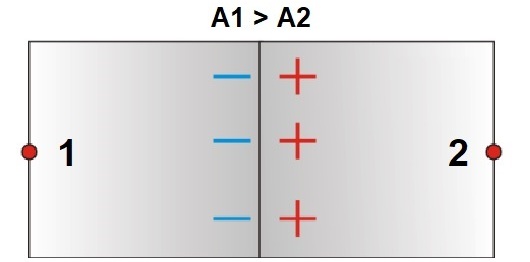
The Italian physicist Alessandro Volta observed this phenomenon and described it. From experience he deduced two laws known today as Volta's Laws.
Volta's first law sounds like this: at the contact of two different metals, a potential difference arises, which depends on the chemical nature and the temperature of the junctions.
Volta's second law: the potential difference at the ends of series-connected wires does not depend on the intermediate wires and is equal to the potential difference that occurs when the outermost wires are connected at the same temperature.
From the point of view of classical electron theory, the unusual results of Volta's experiment are explained quite simply. If we take the potential outside the metal as zero, then inside the metal with a potential? The I energy of the electron relative to the vacuum will be equal to:

Bringing two different metals with work functions A1 and A2 into contact, we will observe an excessive transition of electrons from the second metal, with a lower work function, into the first metal, the work function of which is greater.
As a result of this transition, the concentration (n1) of electrons in the first metal will increase compared to the concentration of electrons in the second metal (n2), which will generate a reverse excess of a diffuse flow of electron gases directed against the flow caused by the difference in working functions.
In a state of equilibrium at the boundary of two metals, the following potential difference will be established:
The value of the stationary potential difference can be determined as follows:
This phenomenon, in which a contact potential difference occurs, which obviously depends on the temperature, is called thermoelectric effect or Seebeck effect… The Seebeck effect underlies the operation of thermocouples and thermoelectric generators.
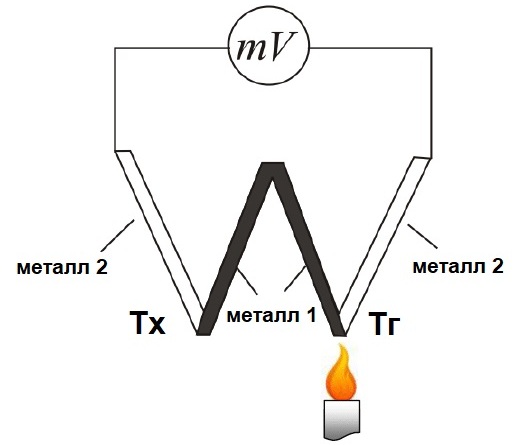
A thermocouple consists of two junctions of two different metals.If one of the junctions is maintained at a higher temperature than the other, then a thermoEMF:
Thermocouples are used to measure temperature, and batteries derived from various thermocouples can be used as EMF sources and even thermoelectric generators.
In a thermoelectric generator, when the junction of two different metals is heated, between the free conductors located at a lower temperature, a thermoelectric potential difference or thermoEMF occurs. And if you close such a circuit to a resistance, then a current will flow in the circuit, that is, there will be a direct conversion of thermal energy into electrical energy.
The Seebeck coefficient, as Volta said, depends on the nature of the metals involved in this thermocouple. ThermoEMF values for various thermocouples are measured in microvolts per degree.
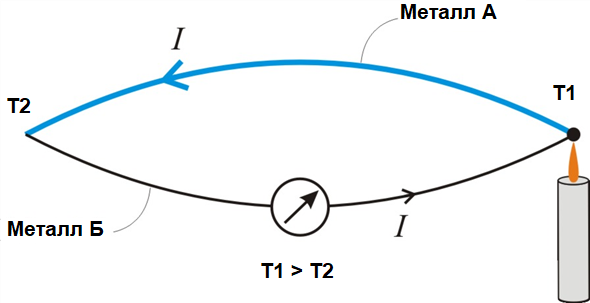
If you take a ring wire composed of two dissimilar metals A and B joined at two places and heat one of the junctions to the temperature T1 so that the temperature T1 is higher than T2 (the temperature of the second junction), then in the hot contact the current will be directed from metal B to metal A, and in the cold - from metal A to metal B. The thermoelectromagnetic field of metal A in this case is considered positive with respect to metal B.
All known metals have their own values of thermoEMF coefficients, they can be arranged consecutively in a column so that each metal shows a positive thermoEMF in relation to the following.
For example, here is a list of the thermoEMF (expressed in millivolts) that will result when the specified metals are combined together with platinum with a contact temperature difference of 100 degrees:
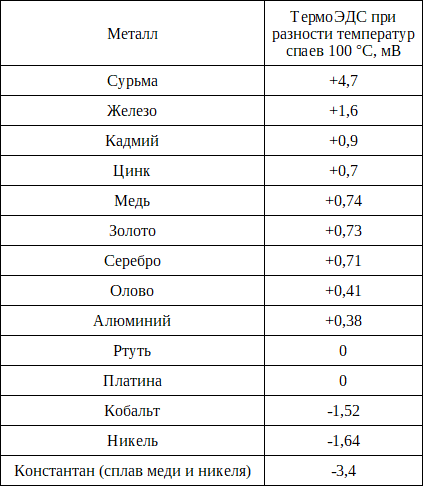
With the help of the given data, it is possible to determine what kind of thermoEMF will turn out if, for example, copper and aluminum are connected and the temperature difference of the contact is maintained at 100 degrees. It is enough to subtract the smaller thermoEMF value from the larger one. So, a copper-aluminum pair with a temperature difference of 100 degrees will give a thermoEMF equal to 0.74 — 0.38 = 0.36 (mV).
Thermoelectric generators based on pure metals are not efficient (their efficiency is about 1%), so they are not widely used. It is worth noting, however, semiconductor thermoelectric converters, which show an efficiency of up to 7%.
They are based on highly doped semiconductors, solid solutions based on group V chalcogenides. To keep the "hot" side at a constant temperature, sunlight or the heat of a preheated oven are suitable.
Such devices are applicable as alternative energy sources in remote sites: lighthouses, weather stations, spacecraft, navigation buoys, active repeaters, stations for anti-corrosion protection of oil and gas pipelines.
The main advantages of thermoelectric generators are the absence of moving parts, quiet operation, relatively small size and ease of adjustment. Their main drawback — extremely low efficiency in the region of 6%, neutralizes these advantages.


